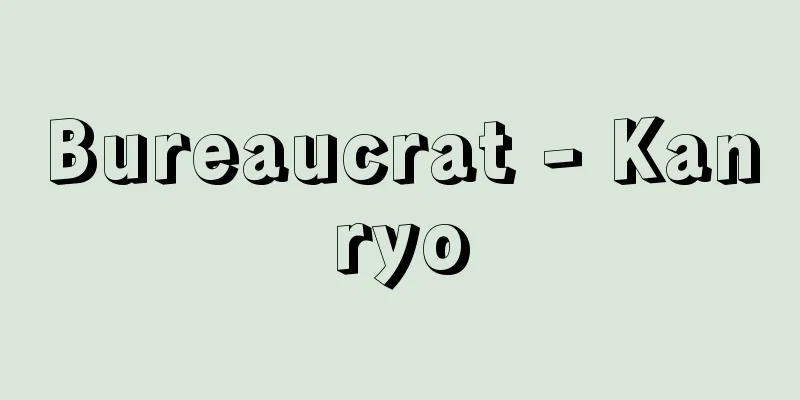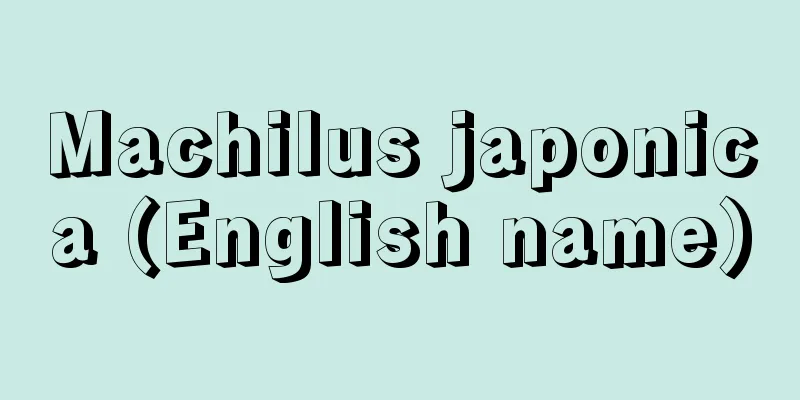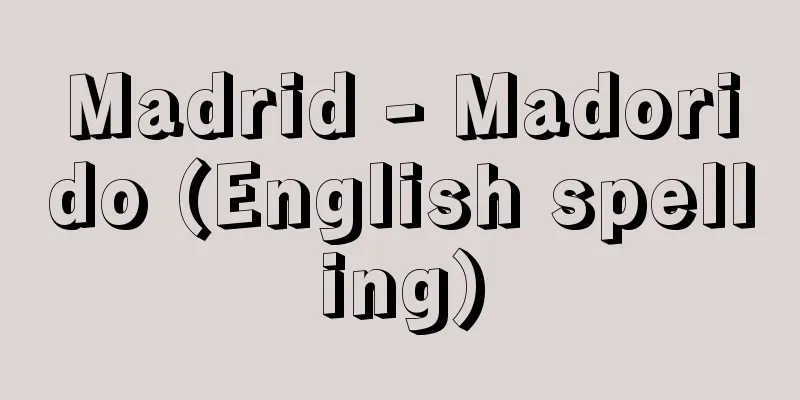Compulsory education - gimukyouiku (English spelling) compulsory education

|
Education that is institutionally compulsory. Its form and significance vary greatly depending on who is forcing what kind of education on whom and for what purpose. Current compulsory education in Japan is an education that is compulsory for all citizens to have their children receive nine years of regular education in regular elementary and junior high schools, as stipulated in Article 26 of the Constitution of Japan, the Fundamental Law of Education, the School Education Law, etc. It is also an education that all citizens are obligated to maintain in order to guarantee the right to education (right to learn) of each and every citizen, as stipulated in Article 26, Paragraph 1 of the Constitution, which stipulates that "All people shall have the right to receive an equal education according to their ability, as provided for by law." [Kimura Tsuneo] The historical nature of compulsory educationHowever, compulsory education of the above-mentioned nature is a very recent phenomenon in world history, and various compulsory education systems with different characteristics have been institutionalized up to now. Next, we will consider the characteristics of these systems by dividing them into five types. [1] Its history began when members of the privileged ruling class made a particular education compulsory for their own children (usually only boys) in order to maintain and strengthen their system. The example of Sparta in Greece is considered a typical example. Moving forward in time, there were many cases in Japan during the Edo period where education at feudal domain schools was made compulsory in the same sense. Similar examples can be found intermittently in Scotland, Russia, and other places. However, these types of cases are rare. [2] In Europe and America, education was made compulsory for the general public, that is, for those who were governed, only after the Protestant feudal states came into being after the Reformation in the 16th and 17th centuries. Naturally, this was deeply connected to the issue of religious freedom, and there were cases such as Massachusetts in the United States, which only made education within the home and the establishment of schools compulsory, but not attendance at those schools, and cases such as the German feudal states, which adopted the principle of religious territoriality and even forced attendance at school. [3] It was not until the 18th century that secular monarchs, in order to increase their wealth, sought to promote education for the general public, establishing schools and making school attendance compulsory. The forerunner of this was Prussia’s “General Local School Act” of 1763. The common feature of these three compulsory education systems is that the survival, maintenance and development of the nation was considered important, and those with physical or mental disabilities who were unlikely to contribute to this were exempt from the obligation. The idea of a right to an education had not yet been considered. [4] The nature of compulsory education has changed significantly with the formation, spread, and development of ideas about human rights. Its origins can be traced back to the so-called modern public education ideas that were formed at the end of the 18th century, around the time of the American War of Independence and the French Revolution. It was not until the 1830s and 1840s in the 19th century that the working classes, who had no real property, began to campaign for the right to education as part of their right to live in Britain, America, Germany, and France. In Britain, America, and France, countries that valued freedom over equality, it was not until the 1870s and 1880s that compulsory school attendance was realized. Moreover, although compulsory education was established in the aforementioned countries at the time, in part due to the movement of the working class, who demanded free public education as a right, in reality it was also the product of a compromise between the privileged class and landlords, who were in conflict with them and saw public education as a means of maintaining order, and the industrial capitalists, who saw it as a source of high-quality, cheap labor. Naturally, it was rare for the right to education to be clearly stated in constitutions or other documents. There was no adjustment to the connection between compulsory education and subsequent education, and it was only in the Midwest of the United States that people were able to receive subsequent education according to their abilities. [5] Compulsory education in Japan before the Second World War was the basis of the Emperor's public education and is said to have been similar in nature to [3]. In fact, the second "Elementary School Act," which was enacted and promulgated just before the issuance of the Imperial Rescript on Education in 1890 (Meiji 23), looked to Germany for its model. However, after the "School System" of 1872 (Meiji 5), three "Education Acts" were passed, and the first "Elementary School Act" was enacted, and the foundations of the compulsory schooling system were laid, and there was a search for the best of the educational systems of France, America, England, and other countries rather than Germany. In 1907 (Meiji 40), compulsory education became six years, and by 1945 (Showa 20), compulsory primary education became eight years, and by combining this with part-time youth school education, which was only for boys, it was planned to complete 13 years of compulsory education from the age of six to 19. Japan's current compulsory education system, mentioned at the beginning, was developed in the above context and was supported by Japan's unique national sense of equality. Through various reforms after World War II, it was reorganized and restructured around the idea of the right to education, or the right to learn. [Kimura Tsuneo] Future challengesThe challenge for the future is how to overcome the reality in which the two principles of "according to ability" and "equal" are in tension with each other, and are permeated by a competitive principle in which one grade point is the key. We must ensure that education that recognizes differences in aptitude and ability and respects individuality does not end up end up endorsing discriminatory education. The above is a common global issue that has continued from the modern era to the present day. [Kimura Tsuneo] "Theory of Compulsory Education" edited by Ito Hideo (1968, Daiichi Hoki Publishing)" ▽ "History of Compulsory Education" edited by Manomiya Yu (included in World Educational History Series, Vol. 28, 1978, Kodansha)" ▽ "Compulsory Education and Coeducation" edited by Hirahara Haruyoshi (included in Selected Documents on the Fundamental Law of Education, Vol. 4, 1978, Gakuyo Shobo)" [Reference items] | | | | |Source: Shogakukan Encyclopedia Nipponica About Encyclopedia Nipponica Information | Legend |
|
制度的に強制された教育。だれが、だれに、いかなる教育をなんのために、強制しているかで、そのあり方や意義は大きく異なる。現在の日本の義務教育は、日本国憲法第26条をはじめ教育基本法、学校教育法等の定めにより、すべての国民が、その保護する子女に、9年間の普通教育を、正規の小・中学校で受けさせるよう、強制された教育である。それはまた憲法第26条1項が、「すべて国民は、法律の定めるところにより、その能力に応じて、ひとしく教育を受ける権利を有する」と定め、国民ひとりひとりの教育を受ける権利(学習権)を保障するために、その維持を全国民に義務づけた教育でもある。 [木村力雄] 歴史的にみた義務教育の性格しかし以上のような性格の義務教育は、世界史的にみても、ごく最近のことで、これまでにそれとは性格を異にするさまざまな義務教育が制度化されてきた。次にその特徴を五つの性格に分けて考察してみる。 〔1〕特権的支配階級に属する者が、その体制の維持強化のために、自らの子弟(原則として男子だけ)に特定の教育を義務づけたことからその歴史は始まる。ギリシアのスパルタの例がその典型とされている。時代は下るが、わが国でも江戸時代の藩校教育のうち、同じ意味で義務化されたものが少なくなかった。スコットランド、ロシアなどにも類似のものが断続的にみられる。しかしこの種の事例はまれである。 〔2〕民衆つまり被治者一般に対し教育が義務づけられるのは、欧米においても16、17世紀以後、宗教改革によりプロテスタントの領邦国家が誕生してからのことである。当然信教の自由の問題と深くかかわり、家庭内の教育や学校の設置だけを義務づけながら、それへの就学は義務づけなかったアメリカのマサチューセッツのようなケースと、信仰属地主義をとり、就学までをも強制したドイツ諸領邦のようなケースとがみられた。 〔3〕世俗国家の専制君主が、その富強のために、国民=庶民一般の教育の振興を図り、学校の設置とともに、就学をも義務づけるようになったのは、18世紀になってからで、プロイセンの1763年の「一般地方学校令」がその先駆といわれる。 以上三つの義務教育に共通する点は、国家の存続維持発展こそが重要であり、それに寄与できそうにない心身に障害のある者たちは義務も免除された。そこには教育を受ける権利といった発想はまだなかった。 〔4〕義務教育の性格は、人権思想の形成、普及、発達によって大きく変質した。その端緒は18世紀末のアメリカ独立戦争期やフランス革命期に形成された、いわゆる近代公教育思想に淵源(えんげん)する。実際に産をもたぬ労働者層が、イギリス、アメリカ、ドイツ、フランスの各国で、生存権の一環として、教育を受ける権利運動を展開したのは、19世紀も1830、40年代になってからのことで、平等より自由を重んじるイギリス、アメリカ、フランスの各国で、さらに就学義務制が実現されたのは、1870、80年代になってからであった。 しかも当時前記の諸国で成立をみた義務教育は、無償の公教育を権利として要求する労働者層の運動も、その成立の一因とはなったが、現実には、彼らと対立し、公教育を秩序維持の手段とみる特権層・地主層と、良質で安価な労働力の供給源とみる産業資本家たちとの妥協の産物でもあった。憲法等に教育を受ける権利がそれとして明記されることも当然まれであった。義務教育とその後の教育との接続も調整されてはおらず、能力に応じて、その後の教育が受けられるようになっていたのは、まだアメリカの中西部だけであった。 〔5〕わが国の第二次世界大戦前の義務教育は、天皇制公教育の基盤をなすもので、〔3〕に類似した性格であったとされている。事実、1890年(明治23)教育勅語の渙発(かんぱつ)直前に制定公布された第二次「小学校令」は、その範をドイツに求めた。しかし1872年(明治5)の「学制」から三つの「教育令」を経て、第一次「小学校令」が制定され、就学義務制の基盤が敷かれるまでには、ドイツよりは、フランス、アメリカ、イギリスなど各国学制の最善良なるものを求めての模索があった。1907年(明治40)には6年制の義務教育、さらに45年(昭和20)までには、8年制となった初等義務教育と、男子だけを対象とするものではあったが、定時制の青年学校教育とをあわせるなら、満6歳から19歳まで、13年間の義務教育が完成する予定であった。 冒頭のわが国の現行義務教育制度は、以上の文脈でわが国固有の国民的平等意識に支えられ形成されてきた義務教育が、第二次世界大戦後の諸改革を通じ、教育を受ける権利=学習権思想を支点に改組再編されたものであった。 [木村力雄] 今後の課題今後の課題は「能力に応じて」と「ひとしく」の緊張関係にある二つの原則が、成績1点を争う競争原理で貫かれている現実を、どう超えるかにある。素質・能力の違いを認め、個性を尊重する教育が、結果として差別教育の是認とならぬようにすべきである。以上は近代から現代への世界共通の課題でもある。 [木村力雄] 『伊藤秀夫編『義務教育の理論』(1968・第一法規出版)』▽『真野宮雄編『義務教育史』(『世界教育史大系 第28巻』所収・1978・講談社)』▽『平原春好編『義務教育・男女共学』(『教育基本法文献選集 第4巻』所収・1978・学陽書房)』 [参照項目] | | | | |出典 小学館 日本大百科全書(ニッポニカ)日本大百科全書(ニッポニカ)について 情報 | 凡例 |
<<: Compulsory Education Expenses National Treasury Subsidy Law
Recommend
Nan Taiheiki - Nan Taiheiki
Written by Imagawa Ryōshun (Sadayo), a military c...
Ohm's law - Ohm's law
This law states that there is a proportional rela...
《Corpus Inscriptionum Latinarum》 (English notation) CorpusInscriptionumLatinarum
…The inscriptions date from the end of the 7th ce...
Knobelsdorff, Georg Wenzeslaus von
Born: February 17, 1699, near Crossen Died Septemb...
Louis Philippe Joseph
…French royalty and politician. The fifth generat...
Nogi [town] - Nogi
A town in Shimotsuga County at the southern tip of...
Good luck - Engi
Broadly speaking, there are three meanings. (1) &...
George V - George
King of England (reigned 1910-1936). Second son of...
bedded deposit
...In the ore layer, parallel stripes are often s...
Caran d'Ache (English spelling) CarandAche
...In the first half or middle of the century, Cr...
Lotus corniculatus (English name) Lotus corniculatus var. japonicus; bird's-foot trefoil
A perennial plant of the legume family. It is also...
Tungsten mineral - tungsten mineral
A general term for minerals whose main component i...
Becker
French film director. Born in Paris. After working...
Rhodos
…A Greek island in the southeastern Aegean Sea, o...
Ireland
◎Official name: Ireland. ◎Area: 72,730 km2 . ◎Popu...









